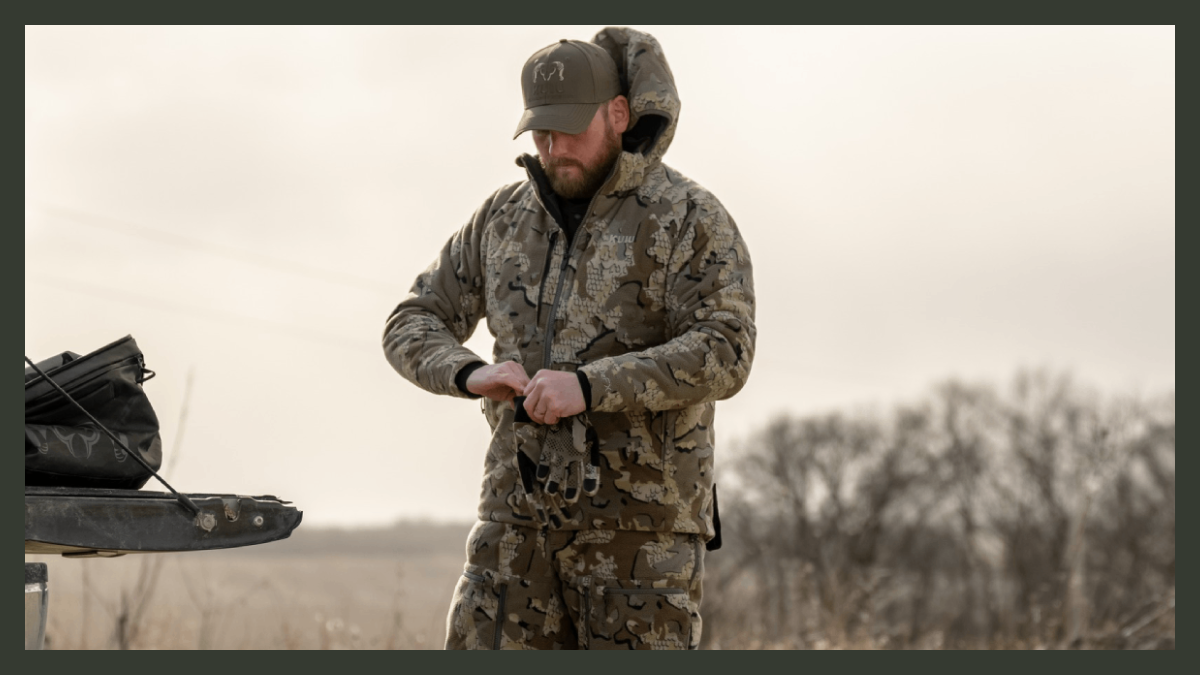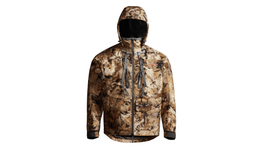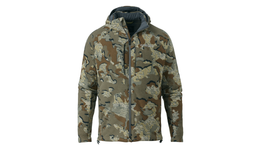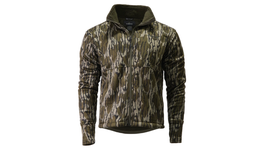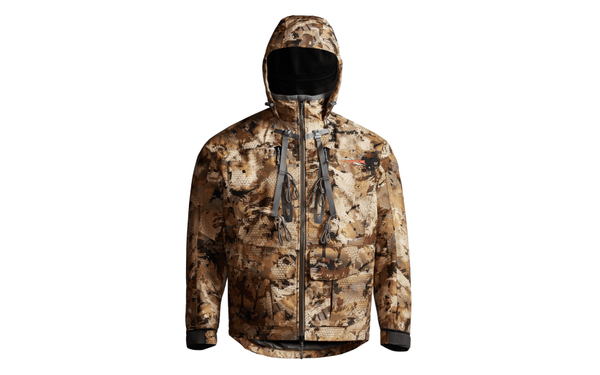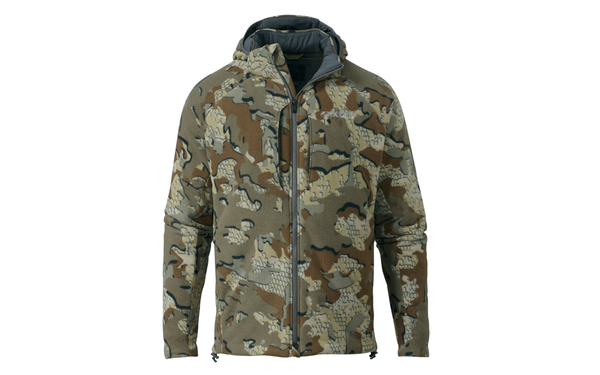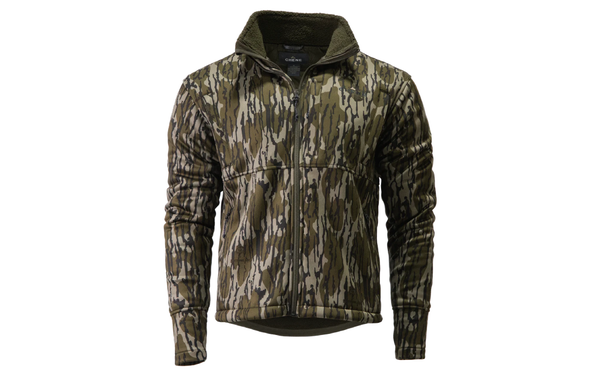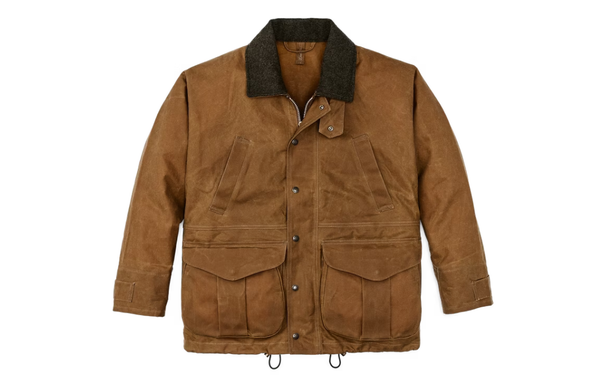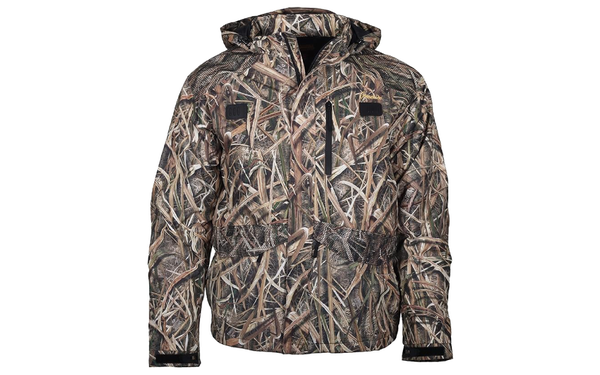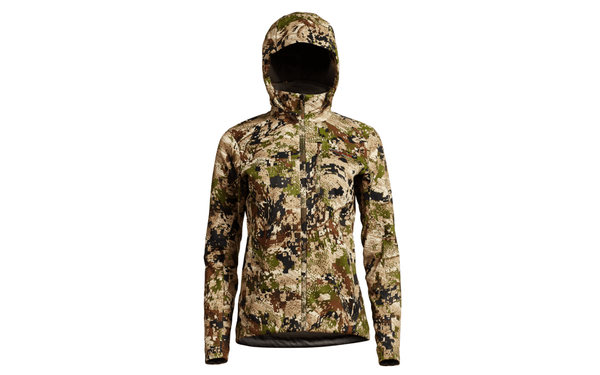We may earn revenue from the products available on this page and participate in affiliate programs. Learn more ›
Hunting jackets are on the long list of things I recall fondly about hunting with my father during the 1970s and 1980s. Sure, I remember his tattered brush pants, old-school camouflage hat, ever-present pack of Camels in his shirt pocket, and the Remington Model 1100 on his shoulder. But most of all, I remember his coat. A Walls, I believe, though it may have been a Carhartt. Plain brown canvas duck with slanted hip pockets—easy access for more shells, he always reminded me—right shoulder padding, and a corduroy collar. Tattered. A little ragged at the bottom. A couple decades of ground-in use. But it was classic. It was his. And it’s what I remember most.
Fast forward four decades later. He still has that coat, though at 82, he doesn’t wear it as often as he did back in the day. Today, he has other jackets—high-tech coats designed to keep him toasty warm. Synthetics. Pockets. Zippers. Camouflage patterns. Removable hoods and inner liners. A far cry, most would agree, from his Carhartt of old.
We’ve taken an in-depth at the latest outerwear to come down the proverbial pike to narrow down the best hunting jackets you can buy today.
The Best Hunting Jackets
- Best Hunting Jacket Overall: Sitka Hudson Jacket
- Best Cold Weather: KUIU Proximity Jacket
- Best for Duck Hunting: Chene Gear Over-and-Under
- Best Upland: Filson Tin Cloth Field Jacket
- Best Budget: Gamehide Slough Creek Jacket
- Best Women’s: Sitka Jetstream Jacket
Best Hunting Jacket Overall: Sitka Hudson Jacket
Specs
- Gore-Tex construction with “stretch” technology and PrimaLoft insulation
- Adjustable hood and water-sealing “gasket” cuffs
- Bellowed shell pockets
- Available in Optifade Timber and Marsh
Pros
- Designed by people who actually hunt
- Excellent wind and water protection
- Great customer service
Cons
- Could be improved with a removable or stow-away hood
- Can be too warm if you’re moving around a lot
I said it before, but it’s worth saying again: The folks at Sitka Gear have come a long way from their first days as clothing designers, especially in the waterfowl arena. I wasn’t a fan of their initial attempts, but today, it’s a different story. To me (as someone who’s been hunting for 48 years), it’s obvious that whoever is sketching Sitka’s designs has actually spent time in the swamp behind a spread of decoys. I don’t mean to gush—really I don’t—but it’s good stuff.
Although the Hudson is an all-season jacket, it truly shines as a waterfowl coat due to its incredible warmth and wind- and water-repelling qualities. (It’s arguably one of the warmest men’s jackets.) And it’s comfortable. I abhor shooting while wearing a heavy coat. However, there are times—think Iowa in January—when warmth simply isn’t an option. Here, the Hudson works, thanks to its stretchiness, which allows full freedom of movement, despite its seemingly bulky appearance.
It may be nit-picky but I’d really like the option to remove the hood. I hate hoods. A zippered pocket in the collar for rolling up the hood and tucking it away would be great. Other than that, you have a definite winner here.
Best Cold Weather: KUIU Proximity Jacket
Specs
- SynthaCell wind-resistant bonded membrane outer
- Body-mapped insulation with anti-odor treatment
- Removable hood
- Full-feature jacket pockets and zippered pockets with handwarmer holders
- Treestand safety harness port
- Four unique camouflage patterns
Pros
- Warm and quiet, the perfect combination
- Roomy but not bulky; can be easily worn over base- and mid-layers
- High level of wind resistance
- Low-sheen finish helps reduce clothing glare or shine
Cons
- Price
I’m admittedly new to Kuiu, though Kuiu isn’t new to the hunting scene, having jumped into the outdoor apparel circle some 11 years ago. Today, Kuiu’s lineup includes everything from hunting packs and tents to socks and boots—and now, the Proximity line of clothing.
The void between warm and quiet as it applies to hunting clothes has traditionally been wide, save for wool, which unfortunately can be quite heavy, especially when wet. Kuiu addressed this gap with the Proximity line, which was designed to “combine industry-leading technology [so that you] remain undetected during close encounters and warm in cold-weather conditions.”
Kuiu accomplishes this thanks to a long list of technological advancements in apparel design and construction. This jacket features a water- and wind-resistant brushed knit outer that’s available in three what I would call old school yet ridiculously effective camouflage patterns (Valo, Verde, Vias) as well as a solid (Ash) that takes the Proximity jacket from the treestand to an evening out without a stutter step.
Best for Duck Hunting: Chene Gear Over-and-Under
Specs
- Insulated upper with sherpa fleece lining and antimicrobial treatment
- Streamlined body-mapped fit with top-to-bottom zipper
- High/low handwarmer pockets
- Available in three Mossy Oak camouflages
Pros
- Exceptionally comfortable fit underneath chest waders
- Non-bulky design that’s big enough to wear over a heavier mid-layer
- Three zippered pockets along with fleece-lined handwarmer pockets
- High collar keeps warmth inside
- Multi-season/multi-species jacket
Cons
- Price tag might be a turn-off for some, but it’s right in the ballpark
Based out of Memphis, Tennessee, Chene Gear is relatively new to the waterfowling stage. That said, they’ve jumped onto said stage with a well thought-out product line that seems to have been designed by men and women who don’t merely hunt ducks, but are truly waterfowl hunters.
Jackets meant to be worn underneath chest waders aren’t anything new but in my opinion, few have hit the mark when it comes to getting it right. Chene Gear, though, tagged a bulls-eye with their O/UJ, which is one of the best duck hunting jackets you can buy. It fits as an under-wader jacket should—roomy up top, form-fitting on the bottom. It’s not restrictive in terms of movement and it’s warm, with secure accessible pockets where you need pockets and without a whole lot of extraneous bells and whistles factored in simply to raise the ‘Cool Level.’
Let me put it this way. Almost five decades hunting ducks, and I have a lot of ‘fowling clothing. But I will be wearing Chene Gear’s O/UJ this fall when I step into the field. Why? Because it works, and not only for ducks, but when I’m sitting in a treestand, hunkered in a ground blind, or still-hunting Washington blacktails.
Best Upland: Filson Tin Cloth Field Jacket
Specs
- Water-resistant construction with seamless shoulder design
- Two-way front zipper with storm flap and adjustable waist and hem
- Lined and zippered rear game bag and/or large pocket
- Wool-lined pockets and collar
Pros
- Incredibly good-looking jacket
- Versatile; can be worn hunting, out on the town, or for doing chores
- Super rugged Tin Cloth exterior
- Nearly perfect in terms of water resistance
Cons
- A little on the pricey side
- Requires periodic maintenance
This is one of the, if not the, best-looking jackets on the planet. Sam Elliot would wear this jacket. That’s good enough for me. Let’s get the downsides (and I use the word loosely) out of the way first. Yes, she’s expensive, but you get what you pay for, and with Filson, you’re paying for the very best quality in terms of outdoor/everyday apparel. This stuff should, if taken care of properly, last a lifetime—and maybe your children’s lifetimes, as well. And speaking of care, Oil/Tin Cloth requires some maintenance in order to keep doing what it’s designed to do, a.k.a. protect you. Just a wipe with a damp cloth and periodic waxing is all it takes.
Regardless, this is an awesome jacket. If you’re an upland bird hunter, Tin Cloth is a blessing, as it repels briars, cockleburrs, beggar ticks, and a long list of ‘pockies,’ as my grandson calls them, like nobody’s business. It’s rugged, wind-resistant, and, once it’s broken in, damn comfortable. It does stiffen up a little in extremely cold temperatures, but it’s a small price to pay. The game pouch/rear pocket is zippered, a nice touch in terms of security and not losing stowed gear. The thigh pockets are big, and protected with a more-than-adequate snap/button closure. Exceptionally cold? The Field Jacket can be fitted with a zip in/out liner, sold separately. My call? If you’re looking for a tough jacket for work, play, or both, you can’t go wrong with this one.
Best Budget: Gamehide Slough Creek Jacket
Specs
- Large zippered pockets and fleece-lined handwarmer pockets
- No-slip shoulder patches and attached adjustable hood
- Gamehide’s “StormHide Gridiron” fabric construction
- Four camouflage options, including Mossy Oak and Flyaway
Pros
- Excellent price point
- Year-round applicability
- Plenty of pockets
- Well-insulated, but not bulky
- Tough, tough, tough
Cons
- Again with the non-detachable hood
Here’s another so-called waterfowl jacket that pulls duty throughout the whole of the season. Yes, it’ll probably be a little warm for September teal hunts and early October archery outings; however, she’s an excellent choice for the vast majority of outdoor excursions.
I’m a huge fan of simplicity and this jacket, along with being well-priced, is every bit of simple. No hidden pockets. No undercover “I can run my iPhone 14 through this!” pouches. No tethers or integrated cords—just a warm coat that stands up to wind, rain, and abuse, and all for right around $100.
The Slough Creek is offered in four versatile camouflage patterns: Mossy Oak Bottomland and Shadow Grass Blades, as well as Flyway Camo and Flyway Camo ‘North.’ A couple of these should work well in a tree stand, while all blend nicely in a variety of waterfowling environments. Insulated, but not bulky. Warm, yet not overly so when it comes time for the work to begin. And did I mention the $100 price tag?
Best Women’s: Sitka Jetstream Jacket
Specs
- Recycled polyester fabric with Gore-Tex Windstopper and taped seams
- Zippered hand and chest pockets
- Armpit ventilation system
- Two camouflage patterns and three solid colors
Pros
- Lightweight yet warm
- Excellent choice when dealing with windy/drizzly conditions
- Top-notch fit
- Plenty of secure pocket space
Cons
- May be out of the ballpark for some in terms of price
- I’m not a fan of Sitka zippers
I had my wife test-drive Sitka’s new women’s Jetstream jacket, and she had this to say following a blustery morning on Willapa Bay raking steamer clams and gunning sand shrimp for sturgeon bait: “The fit impressed me. It fit extremely well—snug, but not too snug. And it wasn’t binding; I could move freely and easily.” She went on to describe the Jetstream as soft and more than capable of fending off the coastal wind and occasional rain. She also loved the zippered pockets, explaining “I’m always bending and kneeling when I’m out here on the bay, and I don’t want to be losing my phone or my license or whatever.”
The Jetstream comes in two camouflage patterns—Optifade Alpine and Elevated II—as well as a trio of solid colors, including Sitka Black, Mud, and Lead. As is the case with many Sitka items, the Jetstream may be pushing the financial envelope for some with its price tag just shy of $400. However, I’m of a mind if you’re looking for quality (something durable that works as marketed and will last for the life of the wearer), those four Benjamins are bills well parted with.
How We Picked the Best Hunting Jackets
- Fit: First and foremost, does it fit? Is it comfortable? Roomy enough to wear overtop a layer or two, if Mother Nature dictates, but not so big as to resemble a U.S. Army issue 1951 mummy style sleeping bag? What’s more, can I shoot effectively while wearing it? That’s a huge deal.
- Function: Does the jacket do what it’s designed to do? Does it keep me warm? Keep me cool? Dry? Out of the wind? Is it breathable or am I wandering around in a sweat sauna?
- Price: Can I afford it, and, if it’s on what I consider to be the spendy side, is it worth the extra money?
- Durability: I take care of my outdoor gear, but I don’t baby it; thus, does Jacket ‘X’ hold up to the rigors which constitute my style of hunting, weather conditions, and old-fashioned toughness?
What to Look For in a Hunting Jacket
Back in my old man’s time, you had warm weather coats, and you had cold weather coats. Now, zip-in/out liners have made the best hunting jackets much more versatile. Buy one, and with a few seconds of intentional customization, you can go from a mid-September teal season to late December greenheads without having to shell out any more of those hard-earned Benjamins.
It’s nice, but this evolution in hunting jacket technology has turned a reasonably simple decision into a true dilemma. Do I need this? That? This other thing? What goes into choosing the best hunting jackets these days?
Purpose/Function
Are you looking for a coat that does it all, or a so-called specialty jacket? A waterfowling parka? Something for early season archery? Or maybe a coat for hunting upland birds, where walking and physical exertion are a constant? Perhaps a jacket with a removable liner is what you’re looking for—something that can be worn September through January, and from the Upper Midwest to South Texas. Consider what you’re planning to do while wearing the jacket.
Price
If your name is Jeff Bezos or Elon Musk, then price might not make a difference; however, to most of us, price is a factor. You can spend $100, or you can spend $500—whatever your wallet will allow.
Weather
This relates back to purpose and function. What’s the weather going to be like when you’re wearing the jacket? Rain? Wind? Snow? Cold? Really, really cold? Light. Heavy. Insulated. Zip-out liner. Non-insulated. Goose down. Wool. Breathable. All things to think about when you’re considering weather and your jacket.
Weight
My old man’s canvas hunting coat was heavy. Throw a bunch of shotshells, a Zippo lighter, cold weather gloves, and a couple Hershey chocolate bars in the pockets, and it then weighed 14 metric tons. While he didn’t seem to mind, how much the jacket weighs is important to most folks, myself included. Humping around the timber during elk season, I’m looking for something lightweight and breathable. Late-season mallards on a tidal marsh, and now it’s waterproof/water-resistant and warm. Here, I don’t mind something heavier because theoretically, I’m not walking around. Much.
Material
Canvas is tough, but it’s heavy. Oilcloth looks really cool and works well, but there’s some periodic maintenance involved. Fleece is warm, but if you’re within 100 miles of beggar ticks or cockleburs, you’re going to be flat covered up if you’re wearing fleece. Similarly, wool is warm but heavy. Then there are high-tech synthetics, blends, and cotton. Think about how you intend to use the jacket, where, and for what.
‘Gingerbread’
Gingerbread refers to the amenities above and beyond the basics, such as warmth, protection from the weather, pockets for your stuff, and a means by which to close the jacket, i.e. buttons or a zipper. Think cell phone pockets. An infinite number of zippers. Drawstrings. Removable hoods. Hidden compartments and passageways. What do you really need, and what might be nice but prove problematic once you wear the jacket afield? Bells and whistles can be okay, but again, what do you really need?
FAQs
Q: How much do hunting jackets cost?
Hunting jackets cost as much as you’re willing to spend. Shop around, and you can pick up a mighty fine jacket for $100 to $125. No bells and whistles, mind you; just a plain ‘ole hunting coat that, with care, should serve you well for many a season. If you have deeper pockets, $300 to $600 isn’t outside the realm of possibility for a high-end jacket.
Q: What makes a good hunting jacket?
Three things: Durability, achievement of intent, and fit. First, the jacket has to stand up to the normal (and often extraordinary) wear and tear we hunters throw at our gear. It’s got to be tough. Second, it must fulfill its intent, whether that be warmth, cooling, rain- and/or wind-resistance, concealment, storage capacity, comfort, or even in-fashion style. And finally, it must fit well.
Q: What’s the best lightweight hunting jacket?
My ideal jacket would weigh about three pounds with a zip-out goose down liner, detachable hood, and 45-degree slit waist pockets, complete with zippers and button-down storm flaps. Inside the left chest, there would be another smaller zippered pocket. Cool mornings, and I’ll leave the liner in; come 10 o’clock and time to walk, I’m losing the liner (which would have its own drawstring stuff sack), and it goes into my pack where it’s barely noticed. The jacket would also be wind- and water-resistant, breathable (without the liner, of course), and bedecked with a Vietnam-era tiger stripe camouflage pattern. That’s not asking too much, is it?
Q: What’s the warmest hunting jacket?
My first impulse for the warmest men’s jackets is to say wool, which might be the case, especially if you’re sitting an Iowa deer stand during January’s late muzzleloader season. Been there, felt that! However, modern synthetic materials not only keep you warm on the chilliest of mornings, but are lightweight and require little to no periodic maintenance, like cleaning or specialized laundering. If you consider yourself old-school, go with wool. If not, look for words and phrases like Gore-Tex, PrimaLoft Insulation, or 3DeFX+.
What is the Best Hunting Jacket?
If you think the way I used to think—that a hunting coat is a hunting coat—I would say it’s high time you stepped back and re-evaluated the hunting jacket game. Given the advancements in garment technology over the past 10 years, there’s absolutely no reason to be cold or wet or hot or sweaty or anything but completely concealed from both the elements and your quarry, thanks to any one of dozens of well-designed styles of outerwear. The challenge today isn’t finding a top-notch coat; rather, it’s choosing one from among the many available. Truthfully? If you have to have a problem, it’s a good problem to have.
- Best Overall: Sitka Hudson Jacket
- Best Cold Weather: KUIU Proximity Jacket
- Best for Duck Hunting: Chene Gear Over-and-Under
- Best Upland: Filson Tin Cloth Field Jacket
- Best Budget: Gamehide Slough Creek Jacket
- Best Women’s: Sitka Jetstream Jacket
Why Trust Us
For more than 125 years, Field & Stream has been providing readers with honest and authentic coverage of outdoor gear. Our writers and editors eat, sleep, and breathe the outdoors, and that passion comes through in our product reviews. You can count on F&S to keep you up to date on the best new gear. And when we write about a product—whether it’s a bass lure or a backpack—we cover the good and the bad, so you know exactly what to expect before you decide to make a purchase.
